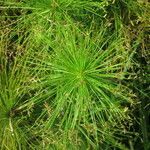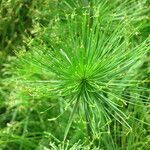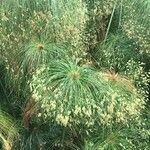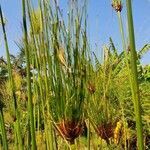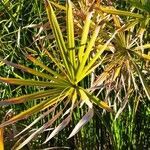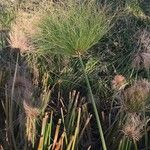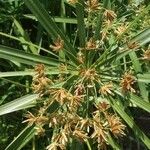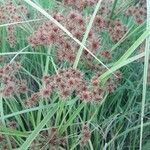A sedge. These grow in clumps and have grass like leaves and solid stalks. It is an erect herb which grows in tufts. It keeps growing from year to year. It grows 2.5 m tall. It has a short, thick, woody underground stem or rhizome. The stems are triangle shaped. The leaves are reduced to brown sheaths. There are 4-10 flowering bracts. These are 7-15 cm long. They are about 1 cm wide. The flower is compound with over 100 branches 10-25 cm long. Each has a sheath like bract 3-5 cm long near the base. There are also 3-5 bracts about 20 cm long at the tip. When the flowers are fertile there are 3-5 spikes with 20-30 spikelets. Each spikelet has 3-20 flowers. These are 1 cm long by 1 mm wide. The nut is 3 sided and brown.
Primary rays of the inflorescence very numerous (30-100). Flowering stems 2-5 m tall, obtusely trigonous or subterete, pithy, the base surrounded by bladeless sheaths. Involucral bracts much shorter than the umbellate inflorescence. Readily recognizable by its up to 5 m tall, pithy stems at the base covered with bladeless sheaths, the umbellate inflorescence with very numerous, subequal rays, and the lanceolate involucral bracts much shorter than the inflorescence.
A robust, perennial herb, up to 5 m high. Culms 2-5 m long, obtusely triangular. Involucral bracts light brown. Leaf blades absent. Inflorescence a compound umbel-like anthela. Glumes light to golden brown.
Characteristic mop-like inflorescences of very numerous primary, often sterile rays
Stems spongy, up to 5 m. high
